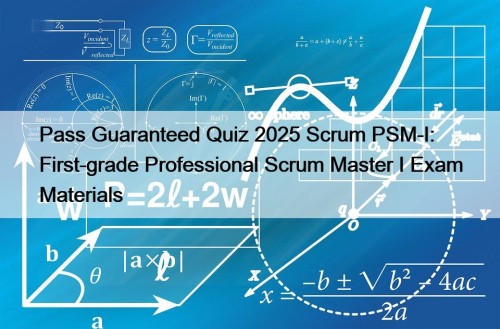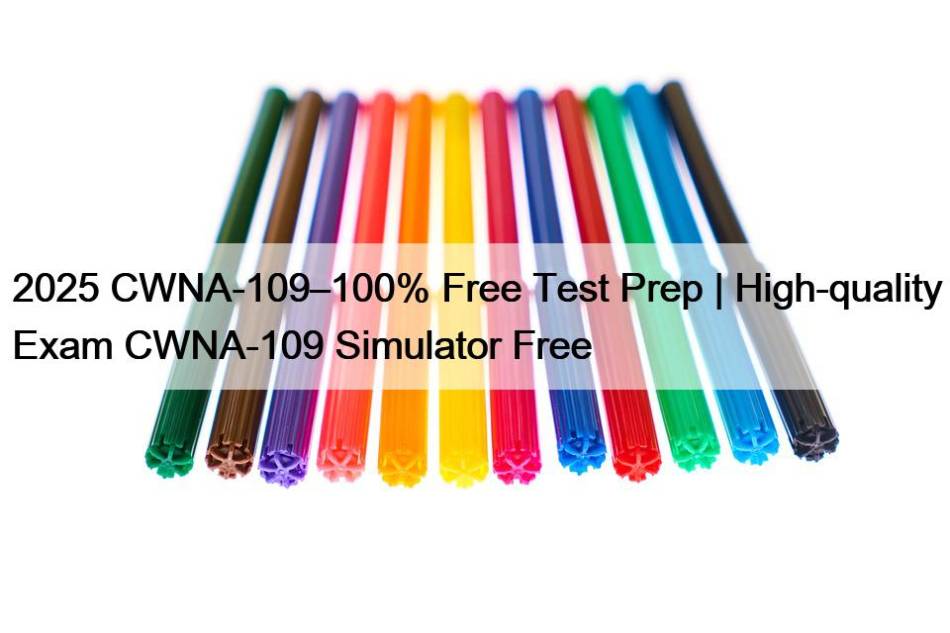Most Popular
 Pass Guaranteed Quiz 2025 Scrum PSM-I: First-grade Professional Scrum Master I Exam Materials
Pass Guaranteed Quiz 2025 Scrum PSM-I: First-grade Professional Scrum Master I Exam Materials
P.S. Free & New PSM-I dumps are available on Google ...
 Reliable Reliable XK0-005 Test Notes bring you the best XK0-005 Books PDF for CompTIA CompTIA Linux+ Certification Exam
Reliable Reliable XK0-005 Test Notes bring you the best XK0-005 Books PDF for CompTIA CompTIA Linux+ Certification Exam
BONUS!!! Download part of PrepAwayETE XK0-005 dumps for free: https://drive.google.com/open?id=1E7TkE1K0xm45l04Ose75OjNUEfrWjI6BOur ...
 Service-Cloud-Consultant Pdf Braindumps, Valid Service-Cloud-Consultant Study Guide
Service-Cloud-Consultant Pdf Braindumps, Valid Service-Cloud-Consultant Study Guide
If you choose the test Service-Cloud-Consultant certification and then buy ...



2025 CWNA-109–100% Free Test Prep | High-quality Exam CWNA-109 Simulator Free

In order to let you have a deep understanding of our CWNA-109 learning guide, our company designed the trial version for our customers. We will provide you with the trial version of our study materials before you buy our products. If you want to know our CWNA-109 training materials, you can download the trial version from the web page of our company. If you use the trial version of our CWNA-109 Study Materials, you will find that our products are very useful for you to pass your exam and get the certification. If you buy our CWNA-109 exam questions, we can promise that you will enjoy a discount.
CWNP CWNA-109 Exam Syllabus Topics:
| Topic | Details |
|---|---|
| Topic 1 |
|
| Topic 2 |
|
| Topic 3 |
|
| Topic 4 |
|
100% Pass Quiz 2025 High Hit-Rate CWNA-109: CWNP Wireless Network Administrator (CWNA) Test Prep
Our CWNP CWNA-109 web-based practice exam software also simulates the CWNP Wireless Network Administrator (CWNA) (CWNA-109) environment. These CWNP CWNA-109 mock exams are also customizable to change the settings so that you can practice according to your preparation needs. DumpsValid web-based CWNA-109 Practice Exam software is usable only with a good internet connection. You can use this CWNP CWNA-109 version on any operating system, and this software is accessible through any browser like Opera, Safari, Chrome, Firefox, and IE.
CWNP Wireless Network Administrator (CWNA) Sample Questions (Q46-Q51):
NEW QUESTION # 46
You are evaluating access points for use in the 5 GHz frequency band. What PHY supports this band and supports 80 MHz channels?
- A. HT
- B. ERP
- C. OFDM
- D. VHT
Answer: D
Explanation:
VHT stands for Very High Throughput, which is a physical layer (PHY) specification that supports the 5 GHz frequency band and supports 80 MHz channels. VHT is used by the IEEE 802.11ac standard, which is also known as Wi-Fi 5. VHT allows for higher data rates and more spatial streams than the previous HT (High Throughput) PHY, which is used by the IEEE 802.11n standard, also known as Wi-Fi 4. HT supports the 2.4 GHz and 5 GHz bands, but only supports up to 40 MHz channels12 The other options are not correct because:
* ERP (option C) stands for Extended Rate PHY, which is a physical layer specification that supports the
2.4 GHz frequency band and supports up to 20 MHz channels. ERP is used by the IEEE 802.11g standard, which is also known as Wi-Fi 3. ERP allows for higher data rates than the previous DSSS (Direct Sequence Spread Spectrum) PHY, which is used by the IEEE 802.11b standard, also known as Wi-Fi 234
* OFDM (option D) stands for Orthogonal Frequency Division Multiplexing, which is a modulation technique that divides a signal into multiple subcarriers that are spaced orthogonally to each other.
OFDM is not a physical layer specification, but a common feature of many PHY specifications, including ERP, HT, and VHT. OFDM allows for higher spectral efficiency and robustness against multipath interference than the previous CCK (Complementary Code Keying) modulation technique used by DSSS34
NEW QUESTION # 47
What frame type is used to reserve the wireless medium for the transmission of high data rate frames that may not be understood by all clients connected to the BSS?
- A. Beacon
- B. PS-Poll
- C. RTS
- D. ACK
Answer: C
Explanation:
The frame type that is used to reserve the wireless medium for the transmission of high data rate frames that may not be understood by all clients connected to the BSS is RTS. RTS stands for Request to Send and is a control frame that is sent by a station to request access to the medium for a specified duration. The RTS frame contains the source and destination MAC addresses, as well as a Network Allocation Vector (NAV) value that indicates how long the medium will be occupied. The destination station responds with a Clear to Send (CTS) frame that echoes the NAV value and grants permission to the source station. All other stations in the BSS hear either the RTS or CTS frame and update their NAV timers accordingly, deferring their transmissions until the medium is free. The RTS/CTS mechanism can be used to prevent hidden node problems, reduce collisions, and protect high data rate frames that use features such as 802.11n or 802.11ac that may not be compatible with legacy stations. ACK, Beacon, and PS-Poll are not used to reserve the medium for high data rate frames. References: [CWNP Certified Wireless Network Administrator Official Study Guide:
ExamCWNA-109], page 112; [CWNA: Certified Wireless Network Administrator Official Study Guide:
ExamCWNA-109], page 102.
NEW QUESTION # 48
What is the most effective method for testing roaming in relation to 802.11 VoIP handsets?
- A. Use a spectrum analyzer to monitor RF activity during a VoIP call.
- B. Use the built-in roaming monitor built into all VoIP handsets.
- C. Place a call with the handset and move around the facility to test quality during roaming.
- D. Use a protocol analyzer to capture the traffic generated when a laptop roams.
Answer: C
Explanation:
The most effective method for testing roaming in relation to 802.11 VoIP handsets is to place a call with the handset and move around the facility to test quality duringroaming. This method allows you to evaluate the actual performance and user experience of VoIP calls over wireless networks, as well as identify any potential issues such as signal strength, interference, latency, jitter, packet loss, or handoff delays. A spectrum analyzer can only show you the RF activity during a VoIP call, but not how it affects the voice quality or roaming behavior. A protocol analyzer can capture the traffic generated when a laptop roams, but it cannot simulate the characteristics of a VoIP handset such as battery life, antenna design, codec support, or QoS features. A built-in roaming monitor is not a common feature in all VoIP handsets, and it may not provide accurate or comprehensive information about the roaming process. References: [CWNP Certified Wireless Network Administrator Official Study Guide: ExamCWNA-109], page 487; [Voice over Wireless LAN 4.1 Design Guide], page 6-19.
NEW QUESTION # 49
The center frequency of channel 1 in the 2.4 GHz band is 2.412 GHz (2412 MHz). What is the center frequency of channel 4?
- A. 2.422
- B. 2.427
- C. 2.413
- D. 2.417
Answer: B
Explanation:
The center frequency of channel 4 in the 2.4 GHz band is 2.427 GHz (2427 MHz). The center frequency of a channel is the midpoint of its frequency range, where the signal strength is highest and most concentrated. The center frequency of channel 1 in the 2.4 GHz band is 2.412 GHz (2412 MHz), as given in the question. The center frequency of each subsequent channel is obtained by adding 5 MHz to the previous channel's center frequency, since the channels are spaced 5 MHz apart from each other in this band. Therefore, to find the center frequency of channel 4, we need to add 15 MHz (5 MHz x 3) to the center frequency of channel 1:
2.412 GHz + 0.015 GHz = 2.427 GHz
Alternatively, we can use a formula to calculate the center frequency of any channel in the 2.4 GHz band:
Center frequency (GHz) = 2.407 + (0.005 x Channel number)
Using this formula for channel 4, we get:
Center frequency (GHz) = 2.407 + (0.005 x 4)
Center frequency (GHz) = 2.407 + 0.02
Center frequency (GHz) = 2.427 References: 1, Chapter 3, page 85; 2, Section 3.2
NEW QUESTION # 50
What cipher suite is specified by the 802.11-2016 standard and is not deprecated?
- A. Counter Mode with CBC-MAC Pro tocol
- B. Extensible Authentication Protocol
- C. Temporal Key Integrity Protocol
- D. Wired Equivalent Privacy
Answer: A
Explanation:
The cipher suite specified by the 802.11-2016 standard and is not deprecated is Counter Mode with CBC-MAC Protocol (CCMP). CCMP is an encryption protocol that uses Advanced Encryption Standard (AES) as the underlying cipher and provides confidentiality, integrity, and origin authentication for wireless data. CCMP is the mandatory encryption protocol for WPA2 and WPA3. References: [CWNP Certified Wireless Network Administrator Official Study Guide: ExamCWNA-109], page 295; [IEEE Standard for Information technology-Telecommunications and information exchange between systems Local and metropolitan area networks-Specific requirements - Part 11: Wireless LAN Medium Access Control (MAC) and Physical Layer (PHY) Specifications], page 1560.
NEW QUESTION # 51
......
Revealing whether or not a man succeeded often reflect in the certificate he obtains, so it is in IT industry. Therefore there are many people wanting to take CWNP CWNA-109 exam to prove their ability. However, want to pass CWNP CWNA-109 Exam is not that simple. But as long as you get the right shortcut, it is easy to pass your exam. We have to commend DumpsValid exam dumps that can avoid detours and save time to help you sail through the exam with no mistakes.
Exam CWNA-109 Simulator Free: https://www.dumpsvalid.com/CWNA-109-still-valid-exam.html
- Valid CWNA-109 Exam Camp 👽 Free CWNA-109 Updates 🤍 New Exam CWNA-109 Materials 📐 Open website ☀ www.passtestking.com ️☀️ and search for ▷ CWNA-109 ◁ for free download 🍋CWNA-109 Frenquent Update
- Instant CWNA-109 Access 🐣 CWNA-109 Reliable Dumps Ppt 👴 CWNA-109 Frenquent Update 🚕 Search on ➤ www.pdfvce.com ⮘ for [ CWNA-109 ] to obtain exam materials for free download 😑Exam CWNA-109 Reference
- CWNA-109 Valid Test Materials 📅 CWNA-109 Valid Exam Objectives 🏁 Exam CWNA-109 Preview 🥢 Search for 《 CWNA-109 》 and easily obtain a free download on ▛ www.lead1pass.com ▟ 🔦Exam CWNA-109 Actual Tests
- CWNA-109 Latest Exam Guide 🧍 CWNA-109 Valid Test Sample 🚅 New Exam CWNA-109 Materials 👋 Download ⏩ CWNA-109 ⏪ for free by simply searching on “ www.pdfvce.com ” 🦔CWNA-109 Latest Exam Guide
- 100% Pass Efficient CWNP - CWNA-109 Test Prep 👗 Download ➥ CWNA-109 🡄 for free by simply entering ▶ www.pass4leader.com ◀ website 🧺Exam CWNA-109 Preview
- 100% Pass Efficient CWNP - CWNA-109 Test Prep ⚡ Download ▶ CWNA-109 ◀ for free by simply searching on ➡ www.pdfvce.com ️⬅️ 🌴Exam CWNA-109 Reference
- 2025 Professional CWNA-109 Test Prep | 100% Free Exam CWNP Wireless Network Administrator (CWNA) Simulator Free 🃏 Search for 【 CWNA-109 】 and obtain a free download on ➡ www.exams4collection.com ️⬅️ 🛳CWNA-109 Frenquent Update
- CWNA-109 Valid Exam Cram 🐋 CWNA-109 Latest Exam Guide 🗨 CWNA-109 Reliable Test Review 🚦 Open ▶ www.pdfvce.com ◀ and search for ☀ CWNA-109 ️☀️ to download exam materials for free 🎨Exam CWNA-109 Reference
- Examinations CWNA-109 Actual Questions 🍛 Valid CWNA-109 Exam Camp 🌙 CWNA-109 Valid Exam Cram 🎉 Search for ▛ CWNA-109 ▟ and download it for free on ➽ www.prep4pass.com 🢪 website 💙CWNA-109 Valid Test Materials
- CWNA-109 Valid Exam Question 😵 Exam CWNA-109 Quiz 🚑 CWNA-109 Latest Exam Guide 🏣 《 www.pdfvce.com 》 is best website to obtain ▛ CWNA-109 ▟ for free download 🎠CWNA-109 Dumps Questions
- Newest CWNA-109 – 100% Free Test Prep | Exam CWNA-109 Simulator Free 🍦 Open website 【 www.prep4pass.com 】 and search for ➤ CWNA-109 ⮘ for free download 🗜Exam CWNA-109 Quiz
- CWNA-109 Exam Questions
- deeplifecourse.allhelp.in techwitsclan.com www.casmeandt.org bavvo.com yblearnsmart.com lms.digitalmantraacademy.com royaaacademy.com.au magickalodyssey.com www.dhm.com.ng jimston766.idblogmaker.com
Tags: CWNA-109 Test Prep, Exam CWNA-109 Simulator Free, CWNA-109 Exam Consultant, Reliable CWNA-109 Exam Online, Valid Test CWNA-109 Fee